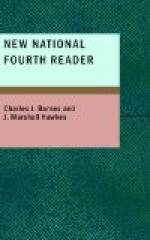No better idea of its strength can be given than the fact of its being employed for riding. A traveler, writing about two ostriches he saw in a village in Africa, says:
“These gigantic birds were so tame that two boys mounted together the larger one. The ostrich no sooner felt their weight, than it started off at full speed and carried them several times around the village.
“This trial pleased me so much that I wished to have it repeated; and in order to test their strength, I had a full-grown man mount the smaller bird, and two men the larger bird.
“At first, they started with caution; but presently they spread their wings and went off at such a speed that they seemed scarcely to touch the ground.”
The voice of the ostrich is deep and hollow, and is said to resemble at times the roar of the lion. The bird frequently makes a kind of cackling noise, and when enraged at an enemy, it hisses very loudly.
Ostriches make their nests in the sand. One female will, in a single season, lay from twenty to thirty eggs, weighing about three pounds each.
Most of these she places in the nest, standing them on one end; but some of them are left outside of the nest as food for her young when they are hatched.
The natives of Africa are very fond of ostrich eggs, using them for food. In taking the eggs, they exercise great caution; for should the birds discover them, they would break all the eggs and leave the nest.
Young ostriches are readily tamed. Some families in Africa keep them as we do chickens. They play with children, sleep in the houses, and when a family moves, the ostriches follow the camels, frequently carrying the children on their backs.
Within the past few years, ostriches have been brought to this country; and places called ostrich farms have been established in California and other States, for the purpose of raising them for their feathers.
* * * * *
Language Lesson.—Let pupils point out any points that are omitted from the following
Analysis.—1. Where the ostrich lives. 2. Its size and appearance—body, head, neck, eyes, feathers, and plumes. 3. Its food. 4. An incident. 5. Its speed. 6. Its strength,—leg and foot. 7. Riding ostriches. 8. Voice of ostrich. 9. Nests and habits of the birds. 10. Ostriches in this country.
Change such points as may be found necessary, and use the analysis in describing some well-known bird.
* * * * *
LESSON LXIV.
plead, urge as a reason.
breach, a breaking, as of a promise.
re buke’, call attention to wrong-doing.
strew, spread; scatter.
chide, find fault with.
re sent’nent, anger on account of an injury.




